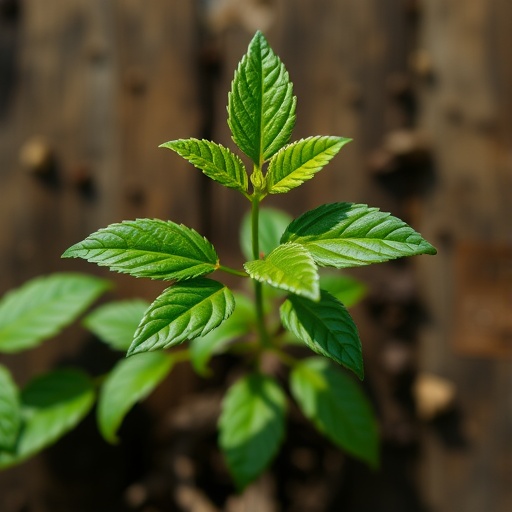In a groundbreaking study set to redefine our understanding of plant immunity, researchers have successfully elucidated the complex biochemical pathway by which rice synthesizes salicylic acid (SA) from phenylalanine. This revelation unravels the sequential enzymatic actions of three pivotal proteins—BEBT, BBH, and BSE—that collectively transform benzylbenzoate into salicylic acid through a previously unknown intermediate, benzylsalicylate. The work not only advances plant molecular biology but also opens promising avenues for engineering disease resistance in crops, with implications extending across multiple plant species.
For decades, salicylic acid has been recognized as a central hormone modulating plant immune responses. Despite its critical role, the detailed biosynthetic route of SA, particularly in monocots like rice, remained partially obscured until now. The latest research utilized a combination of isotope labeling and genetic mutant analyses to pinpoint how phenylalanine derivatives are enzymatically modified to eventually yield SA, thus filling a key gap in plant biochemistry.
Central to these findings are the enzymes OsBEBT, OsBBH, and OsBSE, whose roles were dissected through mutant rice lines lacking either of these genes. Feeding the plants with deuterium-labeled benzylbenzoate allowed the team to trace the metabolic fate of this compound in vivo. While mutants deficient in OsBEBT maintained normal levels of labeled SA, those lacking OsBBH or OsBSE exhibited negligible accumulation, confirming that benzylbenzoate serves as a substrate upstream of these enzymes. This metabolic bottleneck clearly demonstrated that OsBBH and OsBSE act sequentially to process benzylbenzoate, thereby orchestrating its conversion to SA.
.adsslot_kJd5BNglIX{width:728px !important;height:90px !important;}
@media(max-width:1199px){ .adsslot_kJd5BNglIX{width:468px !important;height:60px !important;}
}
@media(max-width:767px){ .adsslot_kJd5BNglIX{width:320px !important;height:50px !important;}
}
ADVERTISEMENT
Further biochemical validation came from transient expression assays in Nicotiana benthamiana leaves, where the individual and combined actions of OsBBH and OsBSE were tested against the backdrop of exogenously supplied benzylbenzoate. Expression of OsBBH alone led to a marked accumulation of benzylsalicylate, the hydroxylation product of benzylbenzoate, but only a modest increase in SA. Intriguingly, when OsBSE was co-expressed with OsBBH, benzylsalicylate levels drastically decreased while SA accumulation spiked, indicating that OsBSE catalyzes the hydrolysis of benzylsalicylate to release free salicylic acid. The enzyme’s specificity was underscored by the fact that OsBSE expressed alone could reduce endogenous benzylsalicylate levels and raise SA, although to a lesser extent, reinforcing its role at the final step of the pathway.
Together, these in vivo isotope labeling experiments and in planta enzyme reconstitution conclusively establish a sequential biochemical cascade wherein OsBEBT generates benzylbenzoate, which OsBBH then hydroxylates to benzylsalicylate, subsequently hydrolyzed by OsBSE to yield salicylic acid. This tripartite module forms a coherent metabolic unit, underpinning a conservation of function across plant species.
Beyond biochemical insights, the study explored the biological ramifications of disrupting this pathway by analyzing disease susceptibility of mutant rice plants inoculated with the fungal pathogen Magnaporthe oryzae. Both lesion size and fungal biomass assessments revealed heightened vulnerability corresponding to the loss of any one of these enzymes, confirming the indispensable role of the BEBT–BBH–BSE pathway in mounting effective rice defense.
The scope of this biochemical module extends beyond rice, supported by gene silencing experiments in other crops, including cotton, tomato, and wheat. Virus-induced gene silencing (VIGS) of BEBT, BBH, or BSE homologs in these species led to notable impairments in pathogen-triggered SA accumulation, underscoring that this pathway is broadly conserved and centrally important in diverse agricultural contexts.
Mechanistically, the conversion of phenylalanine through this distinct route highlights how plants leverage chemical modifications such as hydroxylation and hydrolysis carefully orchestrated by specialized enzymes to fine-tune immune signaling molecules. Benzylbenzoate, previously viewed chiefly as a secondary metabolite, here emerges as a critical metabolic intermediate channeling carbon flux into defense hormone synthesis.
The elegance of this pathway also raises exciting possibilities for biotechnological interventions. By manipulating expression levels or enzymatic efficiencies of BEBT, BBH, and BSE, crop resilience could be enhanced without resorting to external chemical treatments. Moreover, this newfound knowledge lays a foundation for breeding programs aimed at improving disease resistance in important staple crops worldwide.
Beyond plant health, understanding this biosynthetic sequence may illuminate fundamental principles of enzyme evolution and substrate channeling, shedding light on how metabolic networks are optimized over millions of years. The modularity of the BEBT–BBH–BSE sequence exemplifies nature’s capacity to evolve intricate yet efficient biochemical pathways critical for survival.
This study stands out not only for its technical rigor—combining isotope feeding, mutant analyses, transient heterologous expression, and pathogen challenge assays—but also for offering a holistic view linking molecular activity to whole-plant physiology and agricultural performance. It heralds an exciting era where dissecting metabolic pathways at atomic precision meets tangible impacts on global food security.
As the plant research community digests these insights, future work will undoubtedly focus on structural enzymology to visualize active sites of BEBT, BBH, and BSE, investigating how substrate specificity and turnover rates are achieved. Additionally, deciphering regulatory networks controlling the expression of these enzymes under biotic stress will expand application horizons.
In conclusion, this landmark investigation elucidates a novel metabolo-signaling axis driving phenylalanine-derived salicylic acid biosynthesis, mediated by the BEBT–BBH–BSE enzyme module. This discovery not only fills a pivotal gap in the biology of plant immunity but also charts new paths for engineering disease resistance in crops, promising sustainable agricultural advancement in a changing climate.
Subject of Research: Phenylalanine-derived salicylic acid biosynthesis in plants
Article Title: Deciphering phenylalanine-derived salicylic acid biosynthesis in plants
Article References:
Wang, Y., Song, S., Zhang, W. et al. Deciphering phenylalanine-derived salicylic acid biosynthesis in plants. Nature (2025). https://doi.org/10.1038/s41586-025-09280-9
Image Credits: AI Generated
Tags: benzylbenzoate metabolism in plantsengineering crop resistance strategiesenzymatic transformation in plantsisotopic labeling in plant researchmolecular biology of plant immunitynovel enzymes in plant pathwaysphenylalanine to salicylic acid pathwayplant salicylic acid biosynthesisrice disease resistance mechanismsrice immunity enhancementsalicylic acid role in plant defenseunderstanding plant biochemistry





